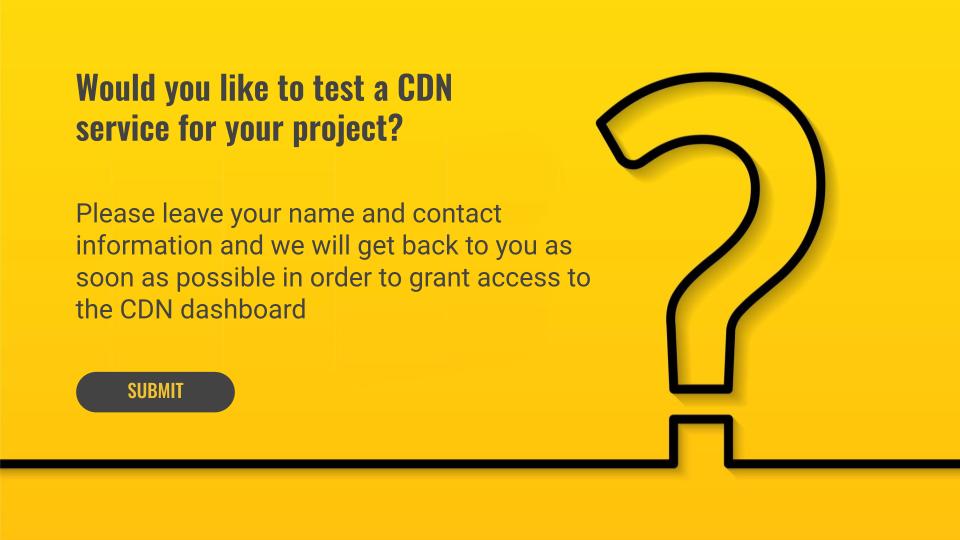The content delivery network is a popular term among game developers, software developers, and CTO recently. If you want to scale your business that includes video content to the next level, it’s time to choose CDN. Unlimited secure storage for media content is a necessity when it comes to the speedy growth of a broadcasting business.
Our storage is a powerful media content platform that helps you compress the images and transcode the video with ease. The playlists functionality helps you create a TV channel of your own out of your VOD files that you want to the group and be displayed in a certain order.
In this article, we will explain what a content delivery network is, how it differs from a web host, and what are its benefits.
Let’s get started!
What is a CDN?
CDNVideo’s Cloud CDN is a content delivery network that particularly accelerates the video content delivery to bring content as close to your users as possible using nodes. This results in low load on the backend servers, cost efficiency, and latency so that your end-user can access the video content with ease.
CDNVideo routes the users to the nearest edge cache and avoids DNS propagation which can impact availability. A CDN is a geographically distributed network of PoPs (Points of Presence) that operates with the purpose to provide a seamless experience to its users.
How does a CDN work?
How CDN video works is interesting. Here’s an example.
Whenever a user lands on your website and tries to access content on your website or application, the request is routed to the nearest edge. From there, the request gets routed to the global HTTP to the origin. It makes the content delivery process fast and easy.
If you have enabled the CDN, the content will be delivered to the end-users from the cached data on the servers thus making the whole process faster and easier. Cached content is the copy of all your content that includes videos, images, and audio that you have stored on the original servers in the form of JavaScript, CSS, and other elements.
When you use the “cache mode” for your CDN, it automatically caches the static content. To have more control over it you can direct the CDN by setting HTTP headers on your responses.
CDN allows you to respond to any queries that are found in the CDN cache. The data is retrieved from the cache and sent to the end-user. The process is called hit cache. This process reduces the load on the original server and minimizes the round trip time.
Whenever a user requests content for the first time, the content request is not fulfilled by the CDN, because it has not been cached yet, this is known as a cache miss. When this happens the CDN tries to get it from the nearby cache. The nearby server uses the cache-to-cache fill to send to the cache first, and then fulfill the query. Otherwise, the request is fulfilled from the original server.
In a cache, the lifetime of an object is defined by the cache directives for each HTTP response or cache mode. When a TTL expires, the content is removed from the cache. TTLs define the maximum lifetime of the object.
Difference between a CDN and a Webhost
Web Hosting allows the users to have one single server location, while CDN has different geographical server locations to access the data. The goal of CDN is to provide data from proximity, thus speeding up the content delivery while reducing the latency over a longer distance.
Servers with a single web host have to bear too much traffic load, however, a CDN offloads the traffic onto different servers.
Benefits of CDNs
Secure, reliable, cost-efficient, and easy to approach. A CDN makes it easier for businesses to deliver web or media content using CDN. The first step to it is creating a bucket, which is also called a Storage bucket that enables caching or setting up your load balancer.
-
How does CDN improve website latency?
One of the significant purposes of the CDN is to minimize the delay in the communication created by the network and reduce latency.
CDN reduces latency by delivering data via its PoPs that enable granular coverage for the region and ensures high-quality content is delivered. It ensures automated mapping and intelligent routing that quickly identifies any issues within the network, troubleshoots them, and analyzes them in a hybrid environment.
Because of the complex nature of the internet and the global traffic, the transition of the information between the website, or applications has to cover large physical distances. It is a two-way communication that requires efficiency, and quick information transfers that are done by CDN.
A CDN is an intermediary server between the end-user and the website/application. It manages the communication between the client and the server. It helps in reducing the total traffic to the web server thus improving the content delivery and reducing latency and bandwidth consumption.
-
How a CDN improves website Reliability and Redundancy?
A CDN keeps the content online even when you have network problems including network congestion or hardware failure. It uses its intelligent failover and maintains various servers at the POPs across various data centers to balance the internet traffic. It stays resilient against service interruptions.
A patented load balancer of a CDN fairly distributes the incoming requests to handle the highest spikes in data in the most efficient way when some of the local servers are redundant. As a result, it increases the processing speed and utilizes server capacity optimally. Load balancing is essential to mitigate the DDoS attacks during which your website receives an abnormally high level of traffic.
Some networks need near-continuous availability and the highest degree of reliability, and failover can rescue the traffic from being lost by directing the traffic to another functional server when one server is not available. Intelligence failures offload tasks to another server in the proximity or a standby stem with available capacity.
-
How does CDN improve Data Security?
A CDN mitigates both large and sophisticated DDoS attacks. DDoS (distributed denial of service) is an attempt to disrupt the normal traffic to a server, network, and any other service by overwhelming the target with a new flood of malicious traffic. The CDN safeguards applications by detecting and mitigating the attempts thus minimizing the latency and downtime.
CDN provides this service without any extra charges. It defends the most frequent DDoS attacks that target an application or a website. With CDNvideo you will get comprehensive availability protection against all known infrastructure attacks.
CDN ensures security since both the data is encrypted at rest and in transit from the load balancing and end-to-end encryption.
With its traffic access control and traffic encryption, a CDN defends the data against any DDoS attacks to improve data security.
Below are some of the DDoS Protection options:
- TCP/UDP filtration;
- WEB Application Firewall(WAF);
- Anti Bot protection.
How do I know if my website needs a CDN?
Almost every business owner and a developer ask this question, whether or not they need a CDN. It’s great to ask yourself the following questions to know if CDN is important for your website.
Your business is growing super fast
Your business is growing super fast. It’s great if your business is growing fast, and you can scale your profits. If your site traffic is growing a regular server will not be able to bear the spike in traffic therefore you should get ready to handle it with a CDN.
Large files make it hard for your website to load quickly
If large files and static content make it hard for your website to load quickly and if they are dragging your site down, you need a CDN. Large files like scripts, CSS, or images can drag your website down. Often websites with tons of media and online magazines experience this.
Your audience base is expanding
If your website audience is expanding fast, and if you notice your visitors scattered around the world, it’s time to incorporate CDN into your business strategy.
How to choose a CDN network
Before you could choose a specific CDN company, make sure you do your research to understand the security concerns and distribution of your content. If it doesn’t guarantee your security, then it is going to screw you up. So be sure of that.
At CDNvideo we provide 9.99% SLA and ready-to-use features like playlists or transcoding to your source video into multiple qualities.
You can store video content of any size, and any volume in a secure place. We understand that you need to access the video content or audio for your listeners and viewers without any delay, to make your users happy. Reach us out to choose your seamless CDN.




